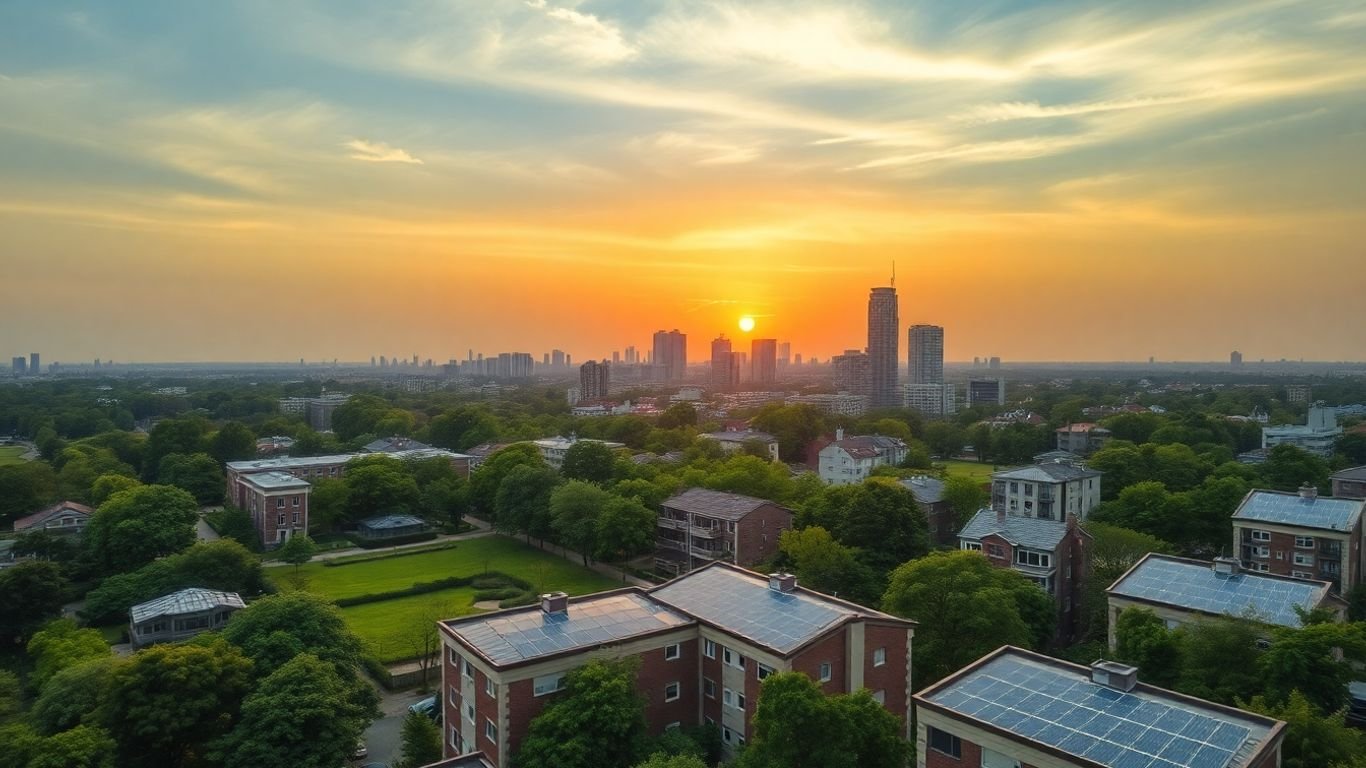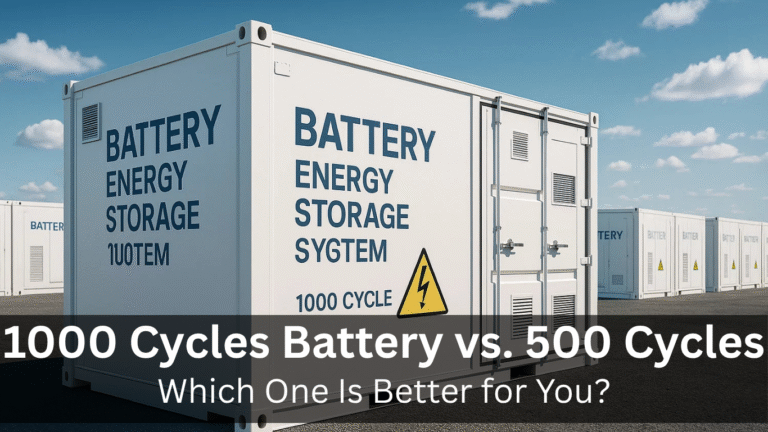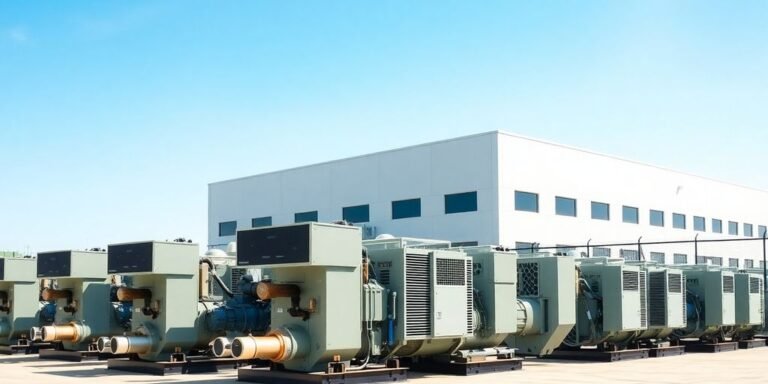Achieving ‘Carbon Neutral Cities’: A Blueprint for Sustainable Urban Futures
Cities are where most of us live, and they use a lot of energy. This means they also create a lot of emissions. But cities can also be leaders in finding solutions. We’re talking about making cities truly carbon neutral, meaning they don’t add to climate change. It’s a big goal, but it’s achievable with the right plans and actions. This article breaks down what it takes to get there, from the energy we use to how we get around and manage our waste.
Key Takeaways
- Cities are major contributors to greenhouse gas emissions, but they also hold the potential to be centers of climate solutions. Achieving carbon neutral cities requires a complete overhaul of how urban areas function.
- Shifting to renewable energy sources like solar and wind is a major step. This means moving away from fossil fuels for power and heating, which significantly cuts down on emissions.
- Rethinking how people move around is key. Encouraging walking, cycling, and using public transport, along with creating zones that limit polluting vehicles, helps lower the carbon footprint of urban travel.
- Better waste management, including reducing landfill waste and adopting circular economy ideas, is important. This helps cut down on methane from landfills and the emissions tied to making and disposing of goods.
- Making buildings more energy-efficient and using sustainable materials in construction are vital. This includes using natural methods for heating and cooling to reduce energy demand.
Foundations For Carbon Neutral Cities
Understanding Net-Zero Versus Low-Carbon Urban Environments
So, what’s the big deal about carbon neutral cities? It’s not just about being a little bit greener. We need to talk about the difference between ‘low-carbon’ and ‘net-zero’. Think of low-carbon as trying to reduce your carbon footprint as much as possible. It’s a good start, for sure. But net-zero? That’s the real goal. It means balancing out all the carbon emissions a city produces with an equal amount that’s removed from the atmosphere. This isn’t just a minor tweak; it’s a complete overhaul of how cities operate. Achieving net-zero districts is becoming a key strategy for creating these sustainable urban areas. It’s about building cities that can handle the future climate challenges.
The Critical Role Of Urban Areas In Global Emissions
Let’s face it, cities are where most of us live. More than half the world’s population is already in urban areas, and that number is only going up. But here’s the kicker: cities are also responsible for a huge chunk of global greenhouse gas emissions – around 60%. As more people move into cities, their impact on the climate is going to get even bigger.
Plus, cities themselves are often hotter than surrounding areas because of all the concrete and buildings, and they’re more vulnerable to things like water shortages and bad air quality. So, if we’re serious about tackling climate change, we absolutely have to get cities on board. Many major cities are already making pledges to be carbon neutral by 2050, which is a big step.
Systemic Transformation For Achieving Net-Zero
Getting to net-zero isn’t something you can do with a few small changes. It requires a deep, systemic transformation. You can’t just focus on what happens inside a city’s borders. Cities need to look at their entire supply chains, the stuff they buy and use that comes from elsewhere, and figure out how to make those cleaner too. They also need to think about how to use natural spaces, both within and around the city, to actually pull carbon out of the air. It’s a complex puzzle, and the order in which you do things really matters because of how infrastructure and habits get locked in over time. It’s a massive undertaking, but it’s possible if we approach it strategically.
Here’s a look at what that transformation might involve:
- Reducing energy use: Making buildings and transport more efficient.
- Switching to clean energy: Moving away from fossil fuels for power and heat.
- Managing waste better: Cutting down on landfill emissions and reusing materials.
- Rethinking transport: Encouraging walking, cycling, and electric vehicles.
- Engaging communities: Getting everyone involved in making sustainable choices.
The path to a carbon-neutral city involves rethinking everything from how we power our homes to how we get around and what we do with our trash. It’s a big job, but it’s necessary for a healthier planet.
Integrating Renewable Energy Sources
When we talk about making cities carbon neutral, one of the biggest pieces of the puzzle is how we power them. For too long, we’ve relied on burning fossil fuels, which pumps a lot of greenhouse gases into the air. Shifting to renewable energy isn’t just a nice idea; it’s a necessary step to clean up our act.
Transitioning Away From Fossil Fuels In Urban Settings
Cities are huge energy consumers. Think about all the electricity needed for homes, businesses, streetlights, and public transport. Traditionally, this power comes from coal or natural gas plants, often located far away but still contributing to the overall carbon problem. The goal here is to move away from these dirty sources. This means phasing out coal-fired power plants that serve urban areas and reducing our reliance on natural gas. It’s a big job, but it’s doable. We need to look at where our energy comes from and make a conscious effort to switch to cleaner options.
Localized Renewable Energy Adoption Examples
It’s not just about massive wind farms or solar arrays, though those are important. We’re seeing some really cool examples of renewable energy being adopted right within cities. For instance, many buildings are now installing solar panels on their roofs. Some cities are even looking at small-scale wind turbines where appropriate. There are also projects that use waste heat from industrial processes or even underground geothermal energy to heat and cool buildings. These localized solutions can make a real difference.
Here’s a quick look at some common renewable sources being used:
- Solar Photovoltaics (PV): Panels on rooftops, building facades, and even floating on reservoirs.
- Wind Power: Smaller turbines in suitable urban locations or larger ones outside the city feeding the grid.
- Geothermal Energy: Using the earth’s stable temperature for heating and cooling.
- Waste-to-Energy: Converting non-recyclable waste into electricity or heat.
The Impact Of Renewables On Carbon Emission Reduction
So, what’s the payoff? When we swap out fossil fuels for renewables, we directly cut down on carbon emissions. Every kilowatt-hour of electricity generated from solar or wind power is one less from a coal plant. This has a ripple effect. Cleaner air in cities, less strain on the environment, and a significant contribution to meeting climate goals. The more we integrate renewables, the closer we get to a truly carbon-neutral city.
The shift to renewables isn’t just about technology; it’s about rethinking our energy systems from the ground up. It involves smart grids, energy storage solutions like batteries, and making sure the energy we generate is used efficiently. This integrated approach is key to making renewable energy work for our cities.
Rethinking Urban Mobility And Transport

Cities are where most of us live, work, and play, and how we get around plays a massive role in our carbon footprint. For a long time, cities were built around cars, leading to a lot of pollution and traffic jams. But we’re starting to see a big shift. The goal is to make moving around cities cleaner, easier, and more enjoyable for everyone, not just drivers. This means looking at everything from how streets are designed to how we encourage people to walk or bike more. Making sustainable transport the easy choice is key to reducing urban emissions.
Reducing Emissions Through Ultra-Low Emission Zones
Ultra-Low Emission Zones (ULEZs) are becoming a popular tool for cities trying to clean up their air. Basically, they’re areas where certain types of vehicles, usually older and more polluting ones, are charged a fee to enter. This encourages people to switch to cleaner cars, use public transport, or find other ways to get around. It’s not about banning cars, but about making the dirtiest ones less appealing to drive in busy city centers. Think of it as a nudge to get people thinking about their travel choices. Cities like London have seen pretty good results with their ULEZ, with noticeable drops in harmful pollutants. It’s a practical step that directly tackles a major source of urban air pollution.
Promoting Cycling And Pedestrian Infrastructure
We need to make walking and cycling not just an option, but a really good option. This means building safe, connected paths for bikes and making sure sidewalks are wide and pleasant to walk on. It’s about creating a city where you don’t have to worry about traffic when you’re on your bike or on foot.
Think about places like Copenhagen, where bike lanes are designed to be direct and safe, often with their own traffic signals. Or Bogotá, with its famous Ciclovía, where streets are closed to cars on Sundays, turning them into public spaces for exercise and socializing. When cities invest in this kind of infrastructure, people are much more likely to leave their cars at home for shorter trips. It’s about making the healthy, low-carbon choice the most convenient one. This kind of investment in sustainable urban mobility strategies can really transform how a city feels and functions.
Behavioral Science To Encourage Sustainable Transport Choices
It’s not just about building bike lanes or setting up ULEZs; we also need to understand why people choose the transport they do. Behavioral science can help here. For example, if you make public transport tickets cheaper or easier to buy, or if you design bus routes that are more direct, people are more likely to use them. It’s also about making sustainable options more attractive.
This could mean better signage for walking routes, apps that show real-time public transport information, or even small incentives for using bikes. Sometimes, it’s the little things that make a big difference in our daily habits. We need to create environments where the low-carbon choice is also the easiest, most affordable, and most appealing choice. It’s about designing our cities and transport systems with people’s actual behavior in mind, not just theoretical models.
Cities are complex systems, and changing how people move around requires a multi-faceted approach. It’s a mix of smart infrastructure, thoughtful policies, and understanding what motivates people. When we get it right, cities become healthier, cleaner, and more livable for everyone.
Sustainable Waste Management Strategies
Dealing with trash is a big part of making cities cleaner and greener. When we just dump everything in landfills, it creates problems. Organic stuff breaks down and releases methane, a greenhouse gas that’s way more potent than carbon dioxide. Plus, all that plastic we use and throw away? It piles up, pollutes our environment, and making it in the first place uses a lot of energy.
Minimizing Methane Emissions From Landfills
Landfills are a major source of methane. We need to get better at diverting organic waste away from them. This means more composting and anaerobic digestion. Think of it as turning food scraps and yard waste into something useful, like fertilizer or biogas, instead of letting it rot and produce harmful gases. It’s a simple idea, but it makes a big difference in reducing the greenhouse effect. Cities like Vienna have shown how effective this can be, turning waste into energy and resources.
Addressing Carbon Footprints Of Plastic Production And Disposal
Plastic is everywhere, and its lifecycle has a significant carbon impact. From the oil used to make it to the energy needed for manufacturing and the pollution from its disposal, it’s a tough problem. We have to think about reducing our reliance on single-use plastics and improving recycling processes. This also means looking at new materials that are easier to break down or reuse. It’s about closing the loop on plastic, so it doesn’t just end up in landfills or the ocean.
Implementing Circular Economy Principles In Waste Management
This is where we really start to change how we think about waste. Instead of the old ‘take-make-dispose’ model, a circular economy aims to keep resources in use for as long as possible. This involves:
- Designing products for durability and repairability.
- Maximizing reuse and repurposing of materials.
- Improving collection and recycling systems to recover valuable components.
- Composting organic waste to create soil amendments.
It’s about seeing waste not as an end product, but as a resource for something new. This approach helps cut down on the need to extract new raw materials, saving energy and reducing emissions across the board. It’s a shift towards a more sustainable way of living and consuming, and it’s key to achieving truly carbon-neutral cities. We can learn a lot from places that are already making strides in this area, like Vienna’s waste management system.
Rethinking waste management isn’t just about getting rid of trash; it’s about redesigning our systems to minimize environmental harm and maximize resource value. It requires a shift in perspective from disposal to recovery and regeneration.
Greening Urban Infrastructure And Buildings
When we talk about making cities carbon neutral, we can’t ignore the buildings and the general infrastructure. These are huge parts of the picture, and honestly, they’ve been a big part of the problem for a long time. Think about all the concrete and steel used in construction – that alone has a massive carbon footprint. But there are ways to change this, and it’s not just about slapping some solar panels on a roof, though that’s part of it.
Reducing Energy Consumption In Buildings
This is probably the most obvious place to start. Old buildings are often energy hogs, leaking heat in the winter and letting the heat in during the summer. We need to get better at insulating them, sealing up those drafts, and making sure windows are efficient. It’s about smart design, too. For instance, some cities are looking at how to repurpose underutilized urban spaces, which can reduce the need for new construction and its associated emissions. The goal is to make buildings use significantly less energy for heating, cooling, and lighting. This means upgrading old systems and, for new builds, making energy efficiency a top priority from the ground up.
Incorporating Alternative Energy Sources In Construction
Beyond just reducing consumption, we need to think about where the energy that is used comes from. This involves integrating renewable energy sources directly into the building process. We’re talking about things like building-integrated photovoltaics (BIPV), where solar cells are part of the building materials themselves, like roof tiles or facade elements. Geothermal systems, which use the earth’s stable temperature to heat and cool, are another great option. It’s about moving away from relying on fossil fuels for every aspect of a building’s energy needs.
Passive Heating And Cooling For Energy Efficiency
This is where smart design really shines. Passive heating and cooling techniques aim to use natural forces to regulate a building’s temperature, cutting down on the need for mechanical systems. Think about how buildings are oriented to take advantage of the sun’s warmth in winter and avoid direct sun in the summer. Natural ventilation is key, too – designing buildings so that breezes can flow through them easily.
Green roofs and living walls are also fantastic. They provide insulation, absorb rainwater, and have a cooling effect through evaporation, which can make a big difference in hot climates. It’s about working with nature, not against it, to create comfortable and energy-efficient spaces. This approach is particularly important in dense urban areas where the ‘urban heat island’ effect can make things much hotter than surrounding rural areas.
The Importance Of Transboundary Supply Chains

When we talk about making cities carbon neutral, it’s easy to get caught up in what’s happening right within the city limits. We focus on local energy, local transport, and local waste. But here’s the thing: cities don’t exist in a vacuum. They’re part of a much bigger picture, especially when it comes to emissions. That’s where transboundary supply chains come into play.
Accounting For Emissions Beyond Administrative Boundaries
Think about all the stuff that comes into your city. Food, electronics, clothes, building materials – they all have a carbon footprint from where they were made, how they were transported, and how they got to you. These are emissions that happen outside your city’s borders, but they’re directly linked to your city’s consumption. Ignoring them means you’re not really getting a true picture of your city’s total impact. It’s like trying to clean your house but only sweeping the living room floor, leaving the dirt from the entryway untouched. We need to look at the whole system, not just the parts we can easily see. This is often called a consumption-based inventory, and it’s a big deal for accurate carbon accounting [d73d].
Decarbonizing Urban Supply Chains
So, how do we tackle these outside emissions? It’s a complex puzzle. For starters, cities can work with businesses to push for greener practices upstream. This could mean encouraging suppliers to use renewable energy or adopt more efficient shipping methods. It’s about building relationships and setting expectations. For example, a city might set procurement policies that favor goods produced with lower carbon emissions. It’s a slow process, but changing what we buy and how we buy it can have a ripple effect. We also need better data to understand where these emissions are coming from. This helps us focus our efforts where they’ll make the most difference.
Utilizing Regional Landscapes For Carbon Sequestration
Beyond reducing emissions from what we consume, cities can also look to their surrounding regions for ways to offset their carbon footprint. This might involve supporting sustainable land management practices in nearby rural areas. Think forests, wetlands, and agricultural lands that can absorb carbon dioxide from the atmosphere. It’s a way of using natural systems to help balance out the emissions that are hard to eliminate entirely. This approach recognizes that cities and their surrounding environments are interconnected, and that a healthy region supports a healthy city.
Here are a few ways cities can engage with their surrounding regions:
- Support sustainable agriculture: Partner with local farmers to promote practices that reduce emissions and improve soil health.
- Invest in reforestation and conservation: Protect and expand natural carbon sinks like forests and wetlands in the surrounding area.
- Develop regional energy grids: Collaborate with neighboring communities to build out renewable energy infrastructure that benefits everyone.
The carbon footprint of a city isn’t just about the smokestacks within its limits. It extends to every product consumed, every shipment received, and every resource extracted to support urban life. Addressing this requires looking beyond the city’s edge and engaging with the broader economic and ecological systems it depends on. This holistic view is key to achieving genuine carbon neutrality.
Community Engagement And Behavioral Change
Making cities carbon neutral isn’t just about fancy tech or big government plans. It really comes down to people. We’re talking about getting everyone, from your neighbor to the local shop owner, on board with making changes. It’s about shifting how we all think and act when it comes to our environment. Cities that really get this right, focusing on how to influence what people do, tend to be way more successful in hitting their sustainability targets. It’s a practical approach that makes a real difference.
The Power Of Hyperlocal Sustainability Initiatives
Think about what happens when a neighborhood decides to tackle a problem together. Instead of waiting for big policies, they just start doing things. This could be anything from setting up a community garden on a vacant lot to organizing a neighborhood-wide recycling drive. These kinds of hyperlocal actions are super effective because they’re fast, people see the results right away, and everyone feels more connected to the effort.
For instance, a simple composting program in one block can cut down on landfill waste and methane emissions almost immediately. It’s proof that small, local solutions can add up to a massive impact. We’ve seen communities divert tons of waste from landfills and even start growing their own food, which cuts down on transport emissions too. It’s about taking ownership of our immediate surroundings and making them better.
Engaging Citizens In Climate Action
Getting people involved is key. Sometimes, folks are hesitant to change their habits. Maybe they don’t know enough, or they worry about the cost. That’s where smart strategies come in. Offering incentives, like small rebates for switching to energy-efficient appliances or tax breaks for installing solar panels, can really motivate people. It’s not just about telling people what to do; it’s about making it easier and more rewarding for them to do the right thing. Collaborating with local groups and city officials also helps a lot. When governments support these local efforts, maybe with some funding or by cutting through red tape, these initiatives can grow much bigger. It’s a partnership that benefits everyone.
Fostering Cultural Shifts Towards Sustainability
Ultimately, we need a bigger change in how we view our relationship with the planet. It’s about moving towards a culture where sustainability isn’t an afterthought, but just how things are done. This means rethinking our consumption habits, valuing durability over disposability, and understanding that our choices have consequences beyond our own homes. It’s a long game, but by focusing on community action and making sustainable choices the norm, we can build cities that are not only carbon neutral but also healthier and more livable for everyone. The goal is to make these changes feel natural, not like a chore. It’s about building a future where living sustainably is simply part of everyday life.
The transition to carbon-neutral cities relies heavily on the active participation and buy-in of their residents. When individuals and communities are empowered and motivated to adopt sustainable practices, the collective impact can be profound, driving significant reductions in urban emissions and fostering a more resilient environment for all.
Moving Forward: Making Cities Truly Green
So, we’ve talked a lot about how cities can go carbon neutral. It’s not just about big ideas; it’s about making real changes happen on the ground. Think better public transport, more green spaces, and smarter ways to use energy and manage waste. It’s a huge job, for sure, and it means cities can’t just focus on what happens inside their own borders. They also need to look at where their stuff comes from and how it’s made.
Getting to carbon neutral isn’t a quick fix, it’s a whole system change. But the good news is, many cities are already on this path, showing us what’s possible. By working together and focusing on these practical steps, we can build cities that are not only better for the planet but also better places to live for everyone.
Frequently Asked Questions
What’s the difference between a ‘carbon neutral’ city and a ‘low-carbon’ city?
Think of it like this: a low-carbon city is trying to reduce its carbon footprint as much as possible. A carbon neutral city goes a step further. It aims to balance out all the carbon it releases by removing the same amount from the atmosphere, essentially reaching zero net emissions. It’s like trying to have a perfectly clean room – one is tidying up a lot, the other is making sure no new mess is made and cleaning up any that does appear.
Why are cities so important when we talk about climate change?
Cities are where most people live and where a lot of activity happens, like factories and transportation. Because of this, cities create a huge amount of the world’s greenhouse gas emissions, which cause climate change. So, if we want to fix climate change, we really need to focus on making cities more sustainable.
How can cities use renewable energy to become carbon neutral?
Cities can switch to clean energy sources like solar and wind power instead of burning fossil fuels (like coal and gas) for electricity and heat. This means installing solar panels on buildings, using wind turbines where possible, and making sure the energy powering the city comes from sources that don’t release greenhouse gases.
What are some ways cities can make transportation cleaner?
Cities can encourage people to use less polluting ways to get around. This includes making it easier and safer to walk and bike by building more paths and lanes. They can also create ‘ultra-low emission zones’ where only cleaner vehicles are allowed, and promote public transport that runs on clean energy.
How does managing trash relate to a city’s carbon footprint?
When trash, especially food scraps, sits in landfills, it releases a gas called methane, which is a powerful greenhouse gas. Also, making and throwing away things like plastic creates a lot of carbon emissions. So, cities can reduce their impact by recycling more, composting organic waste, and finding ways to reuse materials instead of just throwing them away.
Does a city need to worry about emissions from things made outside its borders?
Yes, definitely! Cities use products and resources that are made in other places. The emissions from making and transporting those things count towards the city’s overall impact. To truly be carbon neutral, cities need to look at their entire ‘supply chain’ – everything that goes into making and delivering the goods and services they use – and find ways to reduce emissions there too.









One Comment